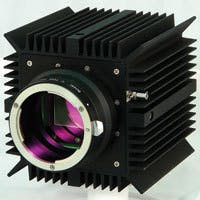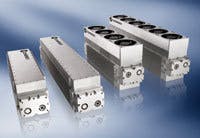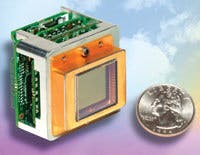Imperx introduces cool cameras for low-noise applications
Imperx Inc. in Boca Raton, Fla., is unveiling the TEC family of cameras for applications requiring the lowest possible thermal noise. The cameras are equipped with thermo-electric cooling of the image sensor and provide a housing designed to make the most of heat removal. Resolutions of 4, 11, and 16 megapixel are available in a standard housing 100 millimeters on a side. Many scientific and low-light-level applications face challenges from thermal noise in the CCD sensor. Controlling this noise enables cameras to operate with long exposure times and provide pixel-by-pixel accuracy. Because thermal noise decreased by 3 dB for every 6-degrees-Celsius drop in temperature, the best way to control thermal noise is to cool the image sensor as much as possible. The TEC series cameras use thermoelectric cooling elements attached to the sensor and are housed in a larger-than-average enclosure with integral heat sink to help dissipate thermal energy efficiently. In addition, the housing encloses the sensor in a sealed chamber equipped with a fill/purge valve. This enables the sensor area to be filled with dry nitrogen to prevent condensation. Working with natural convection, the cameras are able to maintain the sensor from 5°C to 10°C below ambient, depending on the sensor used. Forced-air cooling can keep the sensor from 15°C to 17°C below ambient. The cameras are rated for operation at ambient temperatures between 0°C and 50°C. The TEC series cameras are available in monochrome or color configurations, offering 8-, 10-, or 12-bit pixel data under software configuration control. Electronic shutter control offers features such as pre-exposure and double exposure and speeds as fast as 1/12000 of a second to as long as 10 seconds. The shutters can be triggered under software control or use external trigger signals in addition to providing programmed exposure times. Automatic iris control is optionally available. For more information contact Imperx online at www.imperx.com.
Coherent introduces high-reliability CO2 lasers
Coherent Inc. in Santa Clara, Calif., is introducing a series of low-power, continuous-wave (CW) carbon-dioxide (CO2) lasers. The Diamond C series consists of sealed lasers with output powers of 30, 40, 55, and 70 watts at 10.6 microns. These lasers offer amplitude stability ±5 percent for air-cooled models and ±3 percent for liquid-cooled units. Output-beam characteristics are M2 <1.2 for 30-watt and 55-watt systems, and M2 <1.3 for 40-watt and 70-watt models. Based on several key design innovations, the Diamond C series has superior performance to earlier sealed CW CO2 lasers, company officials say. Innovations include the use of components and resonator materials that optimize laser efficiency and lifetime. In addition, laser cooling and temperature control have been improved to further benefit laser stability and lifetime. Diamond C series lasers are for materials-processing applications, such as marking and engraving, which generally require output powers of less than 100 watts. The RF power supply is inside the laser head. Typical marking applications include processing plastics, paper, medical packaging, PC boards, and low-cost semiconductor products. For more information contact Coherent online at www.Coherent.com.
Thermoteknix launches MIRICLE always-on thermal-imaging camera
Thermoteknix in Waterbeach, England, is offering an alpha-silicon-based focal-plane-array thermal-imaging camera with shutterless XTi technology, the MIRICLE 110KS with XTi. The compact, uncooled, and unstabilized solid-state high-resolution infrared camera also includes “never blind” thermal imaging. The camera is designed without a shutter or any moving parts to interrupt vision at critical moments and is unaffected by shock or vibration. The camera provides continuous high-resolution thermal imaging with no image deterioration with time or ambient temperature change, company officials say. The removal of the shutter and associated motor, gears, and control means that MIRICLE cameras with XTi technology are small, light, and low power consuming. For more information contact Thermoteknix online at www.thermoteknix.com.
LPKF offers laser-based circuit-board production on demand
LPKF Laser & Electronics in Wilsonville, Ore., is introducing the ProtoLaser 200 laser system for prototyping and on-demand production of printed circuit boards. This enclosed laser-based system works off of CAD data to produce circuits on a variety of materials, including ceramic- and PTFE-based substrates. The protective cabinet allows for a Class 1 laser safety rating and prevents any particles or evaporation from leaving the work area. The performance and speed of this system makes it applicable to RF and microwave engineering environment including antennas, RFID, filters, and single-layer components. A visible laser image is projected on to the work surface, outlining the preferred work area, prior to the actual laser structuring, while alignment of two-sided artwork is automated with a fiducial recognition camera. This vision system also allows the ProtoLaser 200 to automatically set the proper laser focal point, visually inspect, and align the work piece. For more information contact LPKF Laser online at www.lpkfusa.com.
Sensors Unlimited offers sensitive InGaAs shortwave IR video camera
Sensors Unlimited Inc. in Princeton, N.J., is introducing the SU640KTSX-1.7RT camera, which offers high sensitivity in the 0.9-to-1.7-micron spectrum with a 640-by-512-pixel format on a 25-micron pitch. The camera is for passive surveillance and for use with imaging lasers, as the lightweight, shortwave infrared camera delivers clear, real-time video imaging in lighting conditions from starlight to direct sunlight. Applications include covert surveillance with passive 24/7 operation, imaging of laser rangefinders and target designators, imaging spectroscopy, astronomy, and other tasks requiring low-light-level shortwave infrared imaging. The indium gallium arsenide (InGaAs) KTSX is available in a 4-cubic-inch, 3.15-ounce OEM module for integration into larger systems. The all-solid-state imager features room-temperature operation with onboard automatic gain control, image enhancement, and built-in nonuniformity corrections. The SU640KTSX is for integration into other systems such as unmanned ground or aerial vehicles and other handheld or robotic systems. Sensors Unlimited is part of Goodrich Corp. For more information contact the company online at www.oss.goodrich.com/sui.






